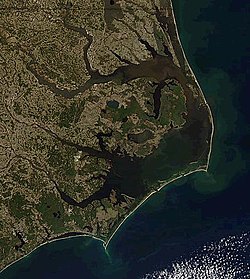Climate
According to the Trewartha climate classification system, Cape Lookout, North Carolina has a humid subtropical climate with hot and humid summers, cool winters and year-around precipitation (Cfak). Cfak climates are characterized by all months having an average mean temperature > 32.0 °F (> 0.0 °C), at least eight months with an average mean temperature ≥ 50.0 °F (≥ 10.0 °C), at least one month with an average mean temperature ≥ 71.6 °F (≥ 22.0 °C) and no significant precipitation difference between seasons. During the summer months in Cape Lookout, a cooling afternoon sea breeze is present on most days, but episodes of extreme heat and humidity can occur with heat index values ≥ 100 °F (≥ 38 °C). Cape Lookout is prone to hurricane strikes, particularly during the Atlantic hurricane season which extends from June 1 through November 30, sharply peaking from late August through September. During the winter months, episodes of cold and wind can occur with wind chill values < 10 °F (< -12 °C). The plant hardiness zone in Cape Lookout is 9a with an average annual extreme minimum air temperature of 20°F. [4] The average seasonal (Dec-Mar) snowfall total is < 2 inches (< 5 cm), and the average annual peak in nor'easter activity is in February.
| Climate data for Cape Lookout, NC (1981-2010 Averages) |
|---|
| Month | Jan | Feb | Mar | Apr | May | Jun | Jul | Aug | Sep | Oct | Nov | Dec | Year |
|---|
| Mean daily maximum °F (°C) | 52.6
(11.4) | 54.1
(12.3) | 59.0
(15.0) | 65.8
(18.8) | 72.8
(22.7) | 80.0
(26.7) | 83.1
(28.4) | 82.6
(28.1) | 79.3
(26.3) | 71.6
(22.0) | 64.2
(17.9) | 56.0
(13.3) | 68.5
(20.3) |
|---|
| Daily mean °F (°C) | 46.4
(8.0) | 48.0
(8.9) | 53.2
(11.8) | 60.6
(15.9) | 68.1
(20.1) | 76.0
(24.4) | 79.5
(26.4) | 78.8
(26.0) | 75.0
(23.9) | 66.1
(18.9) | 57.9
(14.4) | 49.7
(9.8) | 63.3
(17.4) |
|---|
| Mean daily minimum °F (°C) | 40.1
(4.5) | 41.8
(5.4) | 47.3
(8.5) | 55.4
(13.0) | 63.4
(17.4) | 71.9
(22.2) | 75.9
(24.4) | 75.0
(23.9) | 70.8
(21.6) | 60.5
(15.8) | 51.6
(10.9) | 43.4
(6.3) | 58.2
(14.6) |
|---|
| Average precipitation inches (mm) | 4.52
(115) | 3.71
(94) | 4.42
(112) | 3.31
(84) | 4.27
(108) | 4.52
(115) | 6.02
(153) | 7.26
(184) | 6.71
(170) | 4.48
(114) | 4.05
(103) | 4.01
(102) | 57.28
(1,455) |
|---|
| Average relative humidity (%) | 74.7 | 75.1 | 74.5 | 74.9 | 76.7 | 79.0 | 82.2 | 79.7 | 78.9 | 75.1 | 77.5 | 75.9 | 77.0 |
|---|
| Average dew point °F (°C) | 38.8
(3.8) | 40.5
(4.7) | 45.3
(7.4) | 52.6
(11.4) | 60.5
(15.8) | 69.0
(20.6) | 73.6
(23.1) | 72.0
(22.2) | 68.0
(20.0) | 58.0
(14.4) | 50.9
(10.5) | 42.4
(5.8) | 56.0
(13.3) |
|---|
| Source: PRISM [5] |
| Climate data for Cape Hatteras, NC Ocean Water Temperature (72 NE Cape Lookout) |
|---|
| Month | Jan | Feb | Mar | Apr | May | Jun | Jul | Aug | Sep | Oct | Nov | Dec | Year |
|---|
| Daily mean °F (°C) | 49
(9) | 46
(8) | 52
(11) | 59
(15) | 68
(20) | 74
(23) | 78
(26) | 80
(27) | 77
(25) | 70
(21) | 58
(14) | 55
(13) | 64
(18) |
|---|
| Source: NOAA [6] |
This page is based on this
Wikipedia article Text is available under the
CC BY-SA 4.0 license; additional terms may apply.
Images, videos and audio are available under their respective licenses.
